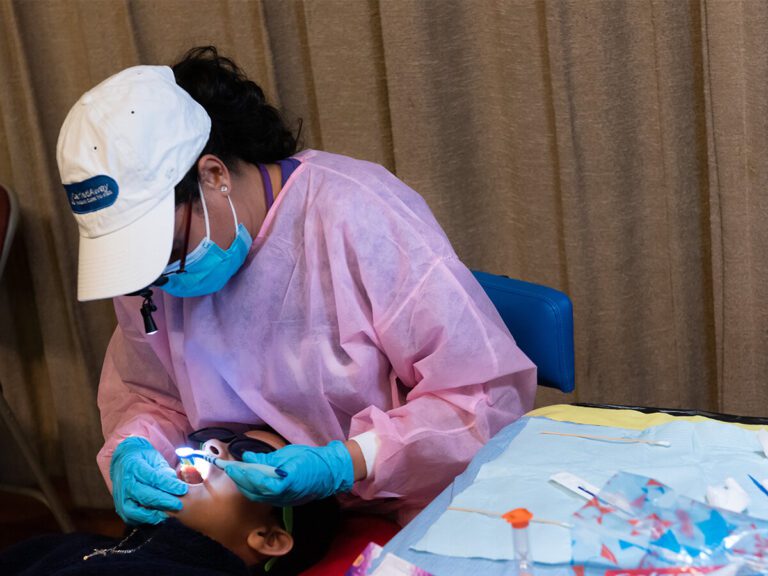A cavity prevention program in Bronx elementary schools was found to prevent 80% of cavities. Credit: NYU Photo Bureau
In a study of nearly 3,000 students, silver diamine fluoride—a liquid that is brushed onto the surface of teeth to prevent cavities or keep them from getting worse—was as effective against tooth decay as dental sealants, the standard of care. A single dose of either topical treatment given in primary schools prevented about 80% of cavities and kept 50% of cavities from getting worse when the children were seen two years later.
The findings, published in JAMA Network Openoffer an effective and cost-effective approach to improving children’s oral health through school-based care.
Cavities are the most common chronic disease in children, and children from low-income families are twice as likely to develop tooth decay as those from higher-income families. Without appropriate and timely intervention, cavities can lead to serious infections, reduce children’s quality of life, and be associated with lower student academic performance and school attendance. But getting kids to the dentist for their recommended twice-yearly visits can be difficult, especially when parents have to take time off from work.
To reduce barriers to visiting the dentist, some basic dental services can be offered in schools, especially those serving children from low-income families. For example, the Centers for Disease Control and Prevention recommends and funds school sealant programs. In 2017, NYU College of Dentistry researchers received funding from the Patient-Centered Outcomes Research Institute (PCORI) to conduct the nation’s largest school-based caries prevention study, which they called CariedAway.
CariedAway is a randomized trial comparing the effectiveness of two cavity prevention techniques: a ‘simple’ treatment with silver fluoride (SDF) and fluoride varnish and a ‘combined’ treatment using traditional glass ionomer sealants and fluoride varnish. Both are noninvasive and applied to the surface of teeth to prevent and arrest tooth decay in children, but for the same time and cost, providers can treat more children with the simpler SDF treatment.
The study included 2,998 children in kindergarten through third grade in 47 New York City schools. The schools—which serve a racially diverse group of students, most of whom come from low-income families—were randomized to receive either the simple or complex treatment.
During each school visit, the clinical research team—which included a supervising dentist, dental hygienists, registered nurses and assistants—performed basic examinations to measure any caries and then applied fluoride varnish and sealants, or SDF, depending on whether the school was assigned to receive the complex or simple treatment.
Initial visits took place in 2019 and early 2020 and were interrupted when the COVID-19 pandemic temporarily closed New York City schools and halted all school care. Two years later, the schools allowed the clinical research team to continue and returned to each school for follow-up visits.
The researchers found that both simple and complex treatments were successful: only one cavity prevention treatment prevented more than 80% of cavities (81% for SDF and 82% for sealants) and halted the progression of half of the cavities (56 % for SDF and 46 % for sealants).
“Without prevention, cavities continue to develop if left untreated. A cavity prevention treatment, CariedAway, given just before schools closed during the pandemic, was highly effective over the next two years,” said Richard Niederman, DMD, professor in the Department of Epidemiology & Health Promotion at NYU College of Dentistry, CariedAway’s co-principal investigator and the study’s senior author. “I know of no other preventive dental intervention that has had such a large beneficial impact throughout the pandemic.”
While the limited availability of trained dental professionals can create challenges for school sealant programs, as sealants are applied by a dentist or dental hygienist, SDF can be an attractive alternative as it can also be applied by nurses – a workforce that already exists in many schools.
“Our results support the use of SDF for cavity prevention in school-based oral health programs and offer an opportunity to expand access to critical oral care,” said Ryan Richard Ruff, MPH, Ph.D., associate professor in the Department Epidemiology & Health Promotion at NYU College of Dentistry, co-principal investigator of CariedAway and first author of the study.
More information:
Ryan Richard Ruff et al, Effect of silver diamine fluoride on caries arrest and prevention, JAMA Network Open (2023). DOI: 10.1001/jamanetworkopen.2022.55458
Reference: School dental program prevents 80 percent of cavities with one-time, non-invasive treatment (2023, February 10) retrieved January 7, 2024 from
This document is subject to copyright. Except for any fair dealing for purposes of private study or research, no part may be reproduced without written permission. Content is provided for informational purposes only.


